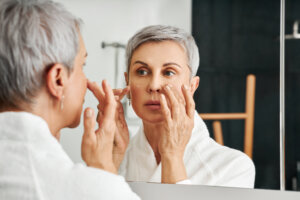“I often see patients for sweaty palms,” says board-certified dermatologist Young McMahan, MD, of U.S. Dermatology Partners in Waco, Texas. The perspiration is usually caused by an underlying condition, but it’s rarely serious and can often be managed with lifestyle changes or medications, she notes.
Read Full Article HerePalms Always Sweaty? Here’s What Your Body’s Trying to Tell You
We’ve all gotten clammy hands at some point or another. But when your palms seem to be sweaty 24/7, the problem can go from embarrassing annoyance to a major concern.
Read on to see what causes sweaty palms and find the right sweaty palms treatment for you. Plus, learn when sweaty palms could indicate a serious health condition.
1. You’re Stressed or Anxious
When the tension starts to rise, it’s normal for your heart to beat faster, your breathing to quicken and your palms to get clammy.
“Anxiety activates the body’s fight-or-flight mode, which gives us the means to protect ourselves. This can result in natural bodily responses, including sweaty palms,” explains Morgan Levy, PhD, a licensed psychologist based in Boca Raton, Florida.
Fix it: One of the best home remedies for sweaty hands caused by stress — and a great way to calm your anxiety as a whole — is by taking deep breaths. “It decreases levels of physical arousal,” Levy explains.
The practice can be as simple as inhaling and exhaling slowly from your stomach while placing one hand on your abdomen and the other on your chest, she says. The 4-7-8 breathing method can be an effective calmer too.
2. It’s Hyperhidrosis
Caused by overactive sweat glands, hyperhidrosis is a condition marked by excessive sweating not brought on by heat, exercise or another underlying medical condition. It often affects the palms, but can also strike on the soles of the feet or the face, according to the Mayo Clinic.
The sweating usually happens on both sides of the body and can be made worse by stress or anxiety, the Mayo Clinic notes. People with hyperhidrosis may also develop secondary rashes from the buildup of sweat and yeast on the skin. “It can cause itching, redness and maceration or breakdown of the skin,” Dr. McMahan says.
Fix it: Keeping the sweat in check usually starts with a prescription-strength antiperspirant (which can be applied to the palms), Dr. McMahan says. “If antiperspirants don’t help, your physician may try different oral medications or therapies, such as ionophoresis or injections with a neurotoxin such as Botox,” she adds.
In severe cases, surgery to remove or deactivate the overactive sweat glands may be needed.
3. You’ve Got Low Blood Sugar
Do sweaty palms seem to strike within a few hours of eating? If they’re accompanied by feelings of hunger, weakness, shakiness or lightheadedness, you could be dealing with reactive hypoglycemia, or low blood sugar that occurs after a meal, notes the Mayo Clinic. The problem often occurs in people with diabetes, per findings in the May 2017 issue of Practical Diabetes, but anyone can potentially be affected.
Fix it: Reactive hypoglycemia with diabetes may be a sign that your insulin or medications may need to be adjusted.
In people without diabetes, solving the low blood sugar problem may be as simple as eating more balanced meals that include both fiber and protein, limiting refined carbohydrates and eating smaller amounts of food more frequently, according to the Mayo Clinic.
4. It’s an Overactive Thyroid
Sometimes sweaty palms can be the result of hyperthyroidism, a condition that occurs when the thyroid gland produces too much of the thyroid hormone thyroxine, according to the National Center for Biotechnology Information (NCBI). This can make the body’s functions speed up, causing a person to feel unexplainably warm or sweaty, have a rapid or irregular heartbeat, feel anxious or irritable, have trouble sleeping, feel shaky or have more frequent bowel movements.
Fix it: Hyperthyroidism requires medical treatment, so call your doctor if you’re experiencing signs or symptoms. Anti-thyroid medications and beta blockers can help bring your thyroxine production back into balance, notes the National Institutes of Health (NIH). Avoiding certain foods can also help.
5. You’re Going Through Menopause
The transition to no longer having a monthly period is triggered by a drop in the production of the hormone estrogen, which can cause a host of unwelcome effects. One of the most common are hot flashes, where the body suddenly becomes warm or flushed and sweaty, according to the Mayo Clinic. The sweat commonly strikes around the chest, neck and face, but hot flashes pose the potential to cause sweaty palms too.
Fix it: Lifestyle changes and natural remedies are the first-line defense: Wearing breathable layers, sleeping in a cool bedroom, avoiding triggers like spicy foods and carrying a portable fan can help keep the sweat in check when you start to get flushed.
Prescription hormone therapy as well as the antidepressant paroxetine are options that can prevent hot flashes from happening in the first place, per the National Institute on Aging.
6. It’s Your Medication
If your palms seem to have started sweating after beginning a new medication, the drug could be the culprit, notes Dr. McMahan. According to the International Hyperhidrosis Society, certain medications used to treat depression, dementia, Parkinson’s disease and chronic pain can cause secondary hyperhidrosis.
Fix it: Let your doctor know if a new drug is making your palms (or other parts of your body) unusually sweaty. You may be able to stop the perspiration problem by having your dosage adjusted or trying a different medication.
7. You Have an Infection
In rare cases, excessive sweating can be a sign of a serious bacterial infection such as tuberculosis or sepsis.
Tuberculosis, a lung infection, can also cause symptoms like long-term coughing, coughing up blood or mucus, chest pain and fatigue, per the Centers for Disease Control and Prevention.
Sepsis may be marked by sweating or clamminess as well as rapid heart rate, shortness of breath, extreme pain, fever or confusion, according to the NIH.
Fix it: Tuberculosis can cause major health complications and sepsis can be life-threatening, so both require immediate medical treatment. See your doctor as soon as you can for signs of tuberculosis and seek emergency medical attention for sepsis.
8. It’s a Rare Condition
Sweaty palms often have a cause that’s straightforward and easy to address. But in some causes, heavy palmar perspiration could be the result of a serious underlying problem such as malaria, certain neurologic conditions or some cancers, according to the Mayo Clinic.
Fix it: If your sweaty hands aren’t explained by any of the above reasons, see your doctor, and let them know about any other symptoms you’re having so they can run the proper tests and make a diagnosis.
When to See a Doctor for Sweaty Palms
Often it’s possible to solve a sweaty palm problem on your own with lifestyle changes. But Dr. McMahan says you should see a board-certified dermatologist if:
- The excessive sweating isn’t going away
- The sweating has changed in severity or frequency
- Sweaty hands are affecting your daily routine or causing you social or emotional distress
- Seek emergency medical attention if the sweating is accompanied by chest pain, nausea or lightheadedness.
“I often see patients for excessive sweating, and through a thorough workup I can help determine whether the hyperhidrosis is primary or secondary,” Dr. McMahan says. “Often, optimizing management of an underlying condition or medication can improve the excessive sweating.”








